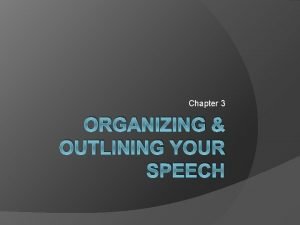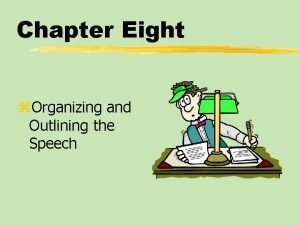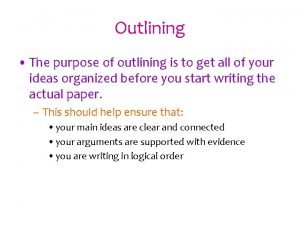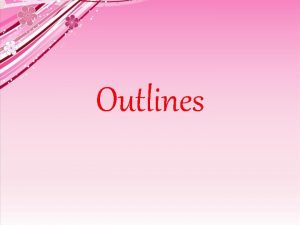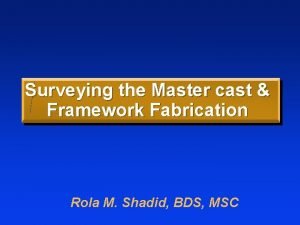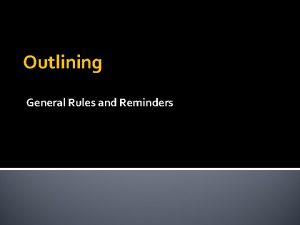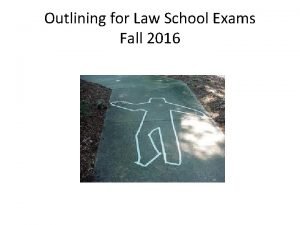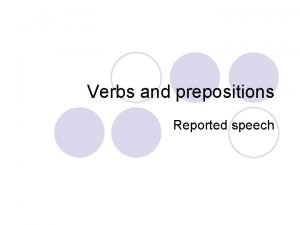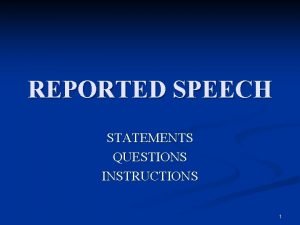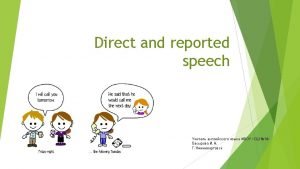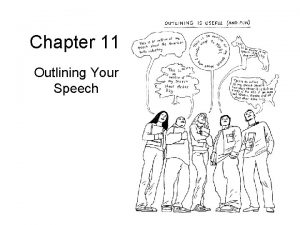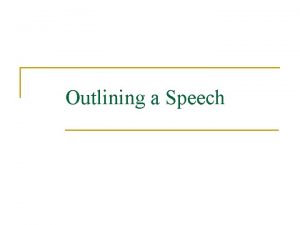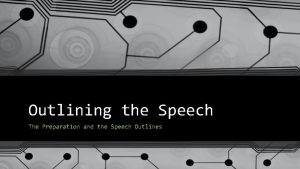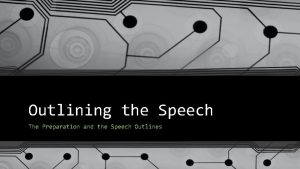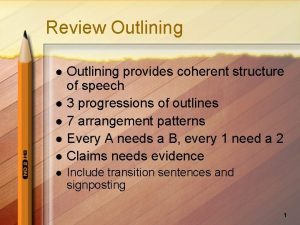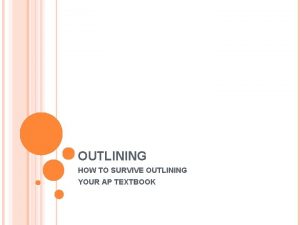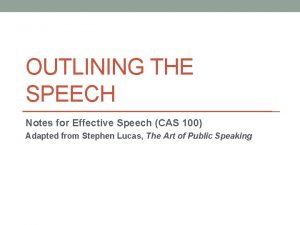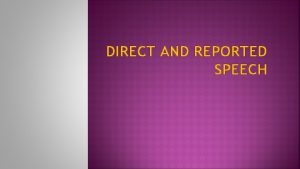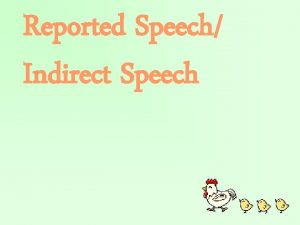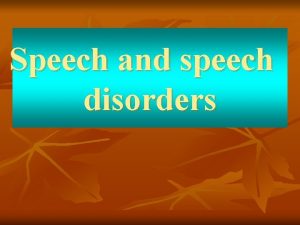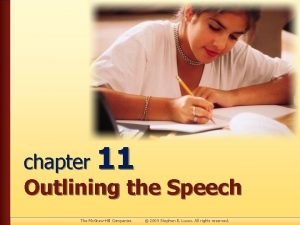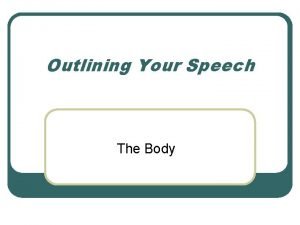Speech Organization And Outlining The Importance of Organization





































- Slides: 37


Speech Organization And Outlining

The Importance of Organization A Well Organized Speech is: –Easier to Understand –Easier to Remember –More Likely to be Believed

Parts of a Speech Introduction Body Conclusion

Standard Outline Format Introduction I. Attention Getter II. Audience Relevancy/Link III. Thesis Statement/Central Idea Preview Statement: One sentence that identifies the main points. Body I. Main Point III. Main Point Conclusion I. Summary Statement (Reflect Preview Statement) II. Reinforcement of Overall Message III. Closure Statement(s)

Steps to Preparing a Speech 1. Brainstorm 2. Research 3. Take Notes 4. Outline 5. Practice 6. Adjust to Meet Time Limitations

Preparing the Body

Devising Main Points 1. Limit the number of main points (2 – 5) 2. Restrict each point to one idea 3. Write Main Points as a statement that can be supported (A Claim needing proof) 4. Customize points for each audience 5. Use parallel language whenever possible (See next slide for a sample of parallel language) 6. Maintain time balance between points

Parallel Language Using the same wording to begin point titles; establishing a pattern Example: I. Swimming dissipates nervous tension II. Swimming avoids muscle and bone injuries III. Swimming builds endurance

6 Organizational Patterns 1. Chronological Order (Time/Sequential) 2. Spatial Order (Location/Arrangement) 3. Cause-Effect Order 4. Problem-Solution Order 5. Topical Order (& Order of Importance) 6. Monroe’s Motivated Sequence

Sample Order of Importance Topic: Types of Drinking Water Main Points: I. Tap Water II. Home Filtered Water III. Bottled Water Order of Importance Themes: Availability Purity Cost

Monroe’s Motivated Sequence 1. Attention (Focus the listener) 2. Need (Define the Problem) 3. Satisfaction (Propose a Solution) 4. Visualization (Benefits of using / Risks of not using the proposed solution) 5. Action (Final challenge / call for action to the audience)

Supply Smooth Transitions – Words or phrases that indicate you are finished with one thought and are moving to another • Bridges – Link parts of the speech together • Internal Summaries – What was covered in the previous point • Internal Previews – What is coming up within the next point • Signposts – Indicate location within the message • Spotlights - alerts to important points

Preparing the Introduction

The Goals of an Introduction • To Gain Attention and Interest • To Apply the Message to the Audience • To Establish Your Credibility • To Preview the Body of the Speech

Attention Getting Devices • Tell a Story • Ask a Question – Rhetorical Questions – Overt-Response • Relate the Topic to the Audience • Cite a Quotation • Arouse Curiosity • Use Audio/Visual Aids • Nonverbal Actions • Humor • Challenges • Suspense • Startle the Audience (Ethically)

Orient the Audience Relevancy Statement: Connects the Attention Getter and the Topic to the Listeners Introduction Content: 1. Provides a message focus that includes: – The Central Idea – A Preview of Main Points 2. Provides Topic Background/Focus 3. Establishes Credibility with Content and Confidence

Central Idea Writing Specific Purpose: To inform my audience about the educational programs offered by the two academic divisions of Del Mar College. Central Idea: Del Mar College offers several educational programs under its two academic divisions. Preview Statement: There are programs offered by the Arts and Sciences division and by the Business and Technology division.

Tips for Preparing the Introduction 1. Keep the introduction brief (10 -20%) 2. Look out for possible opening materials 3. Be creative in devising the introduction 4. Don’t worry about wording until the speech body is complete 5. Work out the introduction in detail 6. Practice, practice the delivery

Presenting the Body 1. Maintain Attention (Use Attention Getting Devices Throughout the Speech) 2. React to Feedback 3. Make Smooth Transitions 4. Avoid Becoming Too Technical 5. Personalize the Speech With -Specific Examples Audience

Preparing the Conclusion

Two Major Functions of a Conclusion 1. To let the audience know you are ending the speech 2. To reinforce the audience’s understanding of (or commitment to) the central idea.

Steps for a Solid Conclusion 1. 2. 3. 4. Signal the Conclusion Summarize the Main Points Reinforce the Central Idea Psychologically Close the Speech • Reference to the Introduction (Attention Getter) • Quotations • Challenge • Dramatic Statement • Rhetorical Questions

Tips for Preparing the Conclusion 1. Keep an Eye Out for Good Closure Material (Quotations, etc. ) 2. NEVER Add New Main Points or Content 3. Conclude With a Bang - Have a Strong and Solid Ending – Avoid “Thank You” and “ The End” 4. Don’t Be Long-winded ( 5 - 10%) 5. Don’t Leave Anything to Chance. Plan It Out in Detail. 6. Practice the Delivery

Outlining


Why Outline? • Establish and Test the Structural Framework • Allows for Adjustments in Planning • Helps in Memorizing the Message • Helps in Preparing Speaking Notes

Types of Outlines • Preparation Outline A fully detailed and labeled outline used in planning the message. • Speaking Outline An abbreviated version of the Preparation Outline used to job memory (also fully labeled).

Preparation Outline Guidelines 1. State the Specific Purpose 2. Identify Central Idea (Thesis) 3. Label Everything (Introduction, Preview, Body, Conclusion, Transitions) 4. Use Proper Symbolization 5. Use Full Sentences 6. Attach a Bibliography (Works Cited)

Symbolization 1. Main Points = Roman Numerals (I, III) 2. Sub-Points = Capital/Upper-Case Letters(A, B, C) 3. Sub-point Details = Arabic Numerals (1, 2, 3) 4. Subordinate Points = Lower-case Letters (a, b, c) 5. Subordinate Points = Arabic Numerals in Parentheses (1) (2) (3) 6. Subordinate Points = Lower-case letters in Parentheses (a) (b) (c)

1 I 2 A. B. C. II III. A. B. 3 4 5 6 1. 2. 1. 2. a. b. (1) (2) (a) (b)

Remember the Rules • If you have a 1, you must have a 2 • If you have an A, you must have a B If there is only one detail, keep it to one point I. I. A. Point: detail 1. Detail B. Point II.

I. Main Point 1 A. B. II. Main Point 2

Speaking Outline Guidelines • Follow the outline framework • Make it legible (type or print) • Keep it brief • Include speaking cues (blocking)

Sample Speaking Outline I. Breathe Smile E/C A. 1. 2. B. V/A II. A. B.

Final Reminders 1. Focus on your audience at all stages of planning 2. Keep your message within time limits 3. Fully develop your outline 4. Carefully prepare your notes 5. Remember that your message will have a lasting impact: Make it solid!

 Organizing and outlining your speech
Organizing and outlining your speech Outlining and organizing the speech contents
Outlining and organizing the speech contents Chapter 11 outlining the speech
Chapter 11 outlining the speech Unity outline
Unity outline The purpose of an outline
The purpose of an outline Types of outlines
Types of outlines Prewriting outline
Prewriting outline Shaped blockout
Shaped blockout The purpose of outlining
The purpose of outlining When to start outlining for law school
When to start outlining for law school Paragraph writing for class 3
Paragraph writing for class 3 Reported speech preposition
Reported speech preposition Pure speech and symbolic speech
Pure speech and symbolic speech Quoted speech vs reported speech
Quoted speech vs reported speech Direct speech present continuous
Direct speech present continuous Pronoun changes in reported speech pdf
Pronoun changes in reported speech pdf Reported speech
Reported speech Joe said please come to my party
Joe said please come to my party Hát kết hợp bộ gõ cơ thể
Hát kết hợp bộ gõ cơ thể Bổ thể
Bổ thể Tỉ lệ cơ thể trẻ em
Tỉ lệ cơ thể trẻ em Voi kéo gỗ như thế nào
Voi kéo gỗ như thế nào Thang điểm glasgow
Thang điểm glasgow Alleluia hat len nguoi oi
Alleluia hat len nguoi oi Môn thể thao bắt đầu bằng từ chạy
Môn thể thao bắt đầu bằng từ chạy Thế nào là hệ số cao nhất
Thế nào là hệ số cao nhất Các châu lục và đại dương trên thế giới
Các châu lục và đại dương trên thế giới Công thức tính thế năng
Công thức tính thế năng Trời xanh đây là của chúng ta thể thơ
Trời xanh đây là của chúng ta thể thơ Mật thư anh em như thể tay chân
Mật thư anh em như thể tay chân Phép trừ bù
Phép trừ bù độ dài liên kết
độ dài liên kết Các châu lục và đại dương trên thế giới
Các châu lục và đại dương trên thế giới Thể thơ truyền thống
Thể thơ truyền thống Quá trình desamine hóa có thể tạo ra
Quá trình desamine hóa có thể tạo ra Một số thể thơ truyền thống
Một số thể thơ truyền thống Cái miệng xinh xinh thế chỉ nói điều hay thôi
Cái miệng xinh xinh thế chỉ nói điều hay thôi
